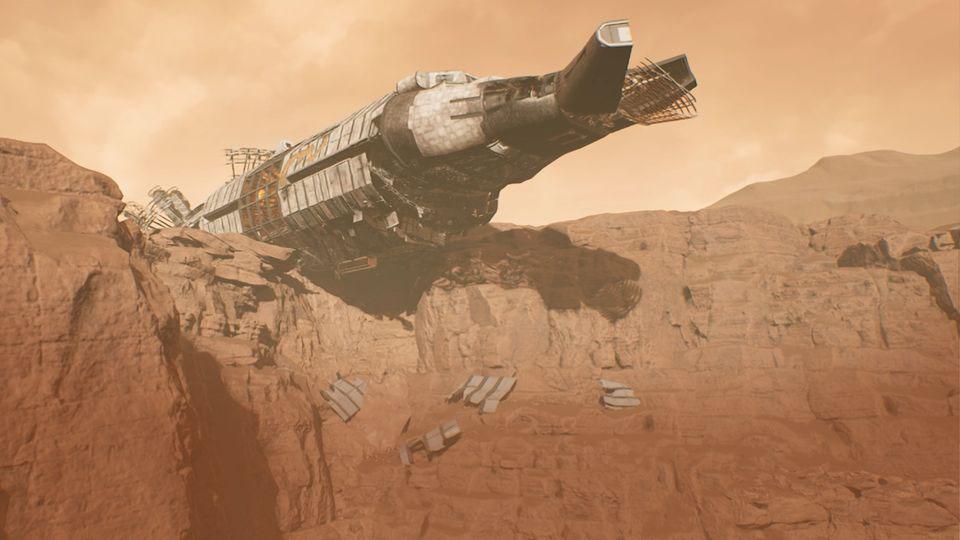Deliver Us Mars
Written by - Codiak
Updated: June 20, 2023
|
Posted: January 31, 2023

Humanity’s hopes lie on Mars. That’s the premise of Keoken Interactive’s upcoming game Deliver Us Mars, and we had the chance to go hands on with a demo of the game ahead of its February 2nd release date. What we had access to was two vertical slices of content from different parts of the game. Anything related to the story, outside of some small moments of comms chatter was not included, and that makes sense because this game, like Deliver Us the Moon, its predecessor, is largely about story, exploration, and discovery.
What this demo really got us comfortable with was a new setting, that being Mars, some of the interesting mechanics presented in the game, and the overall tone and direction of the action.
I want to start by level-setting because while we didn’t get the full scope of the game with our short demo there’s enough, we can glean from the various trailers and official website to let you know what to expect come launch.
Deliver us Mars is an atmospheric sci-fi adventure game. There’s no combat which means the adventure comes in the form of discovery. As the player you must complete puzzles, traverse the red planet, navigate through relics of the ark colony ships, all in an attempt to uncover the mystery of the alien world.

In this genre there are two games I like to point to as the gold standard, that being Firewatch one of my absolutely favorite atmospheric thrillers, and Outer Wilds a game I’ll admit I didn’t play until last year. What a mistake that was.
Deliver Us Mars is a much more linear experience and pseudo-sequel to the developers first game. 10 years after the events of Deliver Us the Moon humanity is closer than ever to extinction. After receiving a distress call from Mars, you join a small crew on a mission to recover the ark colony ships stolen by the mysterious outward. The game will take you from earth all the way to the red planet where you discover the truth about the distress calls’ origins.
That’s as much as we know about the story, and honestly let’s keep it that way. The absolute best part about these types of games is how they unfold, in real time, for the player.
What I wish I had gotten a better sense for was the performances of the characters. In the small interactions I did get to experience I was wowed by the voice acting, but less so by the animations. The game touts some impressive motion capture technology, but I wasn’t really wowed by those intimate person to person moments. Again, the demo didn’t really highlight those things and the various trailers have presented the characters in a slightly better light, but at the end of the day I was playing the game and looking at this with my own two eyes, and I wasn’t wildly impressed.
The story is great, and it’s really the centerpiece to an experience like this, but in our hands-on with the game we got to experience some of the important gameplay features that really help define the adventure. First is one of the most unique climbing mechanics I’ve experienced in a game, ever. The concept is pretty neat. Your character has two climbing picks. As you attempt various elements in the environment you must independently control when and where you move each arm. It’s a fun twist on climbing in general, something we’ve done hundreds of times before, and really presents a simple concept in a unique way.

Another aspect of the game we got a taste of were the puzzles. The first type of puzzle we experienced through the first-person lens of our trust floating robot companion. The goal is to align the various floating blocks to create a singular shape and you do this by moving across the three axis until the puzzle is aligned. These are fun, and simple, and unlock clues in the story.
The more challenging experience was what I can only describe as energy puzzles. These all present slightly differently but the idea is to use stationary and mobile powered platforms to link up energy beams and power up some sort of device. The end goal could be to unlock a door, or power up a massive piece of technology, it varies. I will say, without any context the puzzles took me a second to figure out. Like I mentioned earlier we experienced two vertical slices of the game and clearly missed some sort of tutorial about how these work. Figuring it out in real time was a bit of a doozy. As far as puzzles go I wasn’t really sold on the concept. For one the comically large energy beams really threw me off and felt out of place. It also obscured your vision and as you’re trying to navigate and see the whole picture it just made it challenging, but not the good kind of challenging, the annoying kind where it’s more of a hindrance than an organic challenge.
Like any good atmospheric adventure game, as soon as you do complete a puzzle, you feel a sense of accomplishment. A door unlocks, something happens in the world, and you can move on to that next objective. What I didn’t exactly love was the fact that the game almost ignores your progress. There are small bits of radio communication that don’t always align with major moments in the experience. For example, after powering up a massive piece of space technology I was hoping for a bit more pomp and circumstance. It felt like a big moment in the adventure and the payoff was a small door opening in the back of the room. I get it, we’re stranded on a hostile planet, but still, a little reward for the effort would have gone a long way.

The last real gameplay system I got to experience was taking control of our floating robot companion. It’s interesting going from third person with our character, then snapping into first person with the robot. Apart from the puzzles I mentioned before, the robot is another means to help the player untangle the mysteries of Mars. You can toggle to the robot at any time and float around as you try and figure out how to solve whatever challenge you’re dealing with. The robot can also navigate ventilation areas and move objects the player cannot so it does become an integral part of your experience. If you’re struggling navigating the world you can also use the robot to just scout out a path ahead and I really enjoyed that aspect of the drone. Ultimately, I didn’t find it detracted from my experience, only enhanced it, which I appreciated.
CONCLUSION
Deliver us Mars is one of those games that clearly isn’t going to hold your hand and while that might not be for everyone, it’s kind of a staple of the genre at this point. There are no waypoints, very few environmental clues, and much like your situation it’s up to you to navigate the world. In the two missions we experienced this was both frustrating and exhilarating. Did I die a handful of times…absolutely, but that’s the trial-and-error loop the game is set up for. Luckily the game is really forgiving when you make a mistake, respawning you at the point right before your death. Amongst the puzzles and climbing there are these cool atmospheric moments that make the adventure feel more real. The team managed to pull this off quite a bit in their first game so when it happened in Deliver Us Mars, that’s when the experience came alive for me.
Look the bottom line is with just a vertical slice of the game, largely based on gameplay it’s hard to say whether Deliver Us Mars is worth picking up. What I can say is this. If you enjoy the type of unaided exploration this genre is known for and are ok with a more AA-experience from a smaller studio then you’ll most likely love this game. Comparatively Deliver Us the Moon was well received by the gaming community and Deliver Us Mars just builds on that formula. The team has expanded since that first game, so I have to imagine we’ll have an even more fulfilling experience come launch day.
Deliver us Mars releases on February 2nd for pc, PlayStation, and Xbox. The game will cost less than 30 dollars and while we don’t know how long the game is, Deliver Us the Moon, the first game took around 5 hours to complete, so my bet is this is a quick play.






